Art World
12 Wildly Popular Everyday Things You Would Never Guess Started Out as Artworks
Some of your favorite places to eat and ways to dress are actually works of art.

Some of your favorite places to eat and ways to dress are actually works of art.

Ben Davis

Can art change the world? The answer, of course, is yes—but not often in the way that artists expect it to. In fact, sometimes artworks change the world so manifestly and with such widespread resonance that we forget artists had anything to do with them in the first place.
Over the past couple of years, I’ve been keeping a back-of-the-mind tally of artworks like these that took on a larger life, or wormed their way into our consciousness so deeply that that they ceased to be artworks and instead became simple facts of everyday life.
Here are several things (or concepts) that emerged from the artist’s studio to conquer the world. Some are inspiring, some are fun, and some are just reminders that you never know how far an outrageous idea is going to go, or what unexpected audiences it might find.
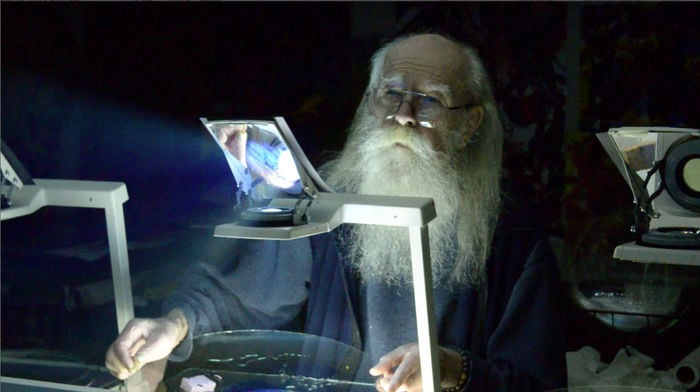
Bill Ham performing a liquid light show. Photo by Lawrence Lauterborn.
Image via De Young Museum.
In the psychedelic 1960s, when bands wanted to add a little visual oomph to their shows, they teamed up with artists… and the concert light show was born. Among the pioneers was Bill Ham, who earned a BFA from the University of Houston in 1954, moving to San Francisco in 1959 to become an artist.
These days, Ham mentions many precedents, including the Dada filmmaker Hans Richter and Bauhaus guru László Moholy-Nagy, but he began making live painting by smearing colors on an overhead projector with more painterly ideas.
“The small works of Wols, as well as Klee and Kandinsky, are similar in scale to the working surface of the overhead projector,” he writes on his website. “And at the same time, the scale of immensity developed by Pollock, Kline, and others was further extended by the properties of projection to allow for large surfaces of instant art.”
After a completely noncommercial start as a member of a regular performance-art collective, Ham’s liquid light shows became a major attraction of rock concerts at the Avalon Ballroom.
“In less than two years, there were too many ‘light-show groups’ to count in the immediate San Francisco Bay Area,” Ham claims. “In addition to the supply-demand factor, the rapid commercialization of the music quickly resulted in the extermination of the ‘happening-performance-environment’ nature of the dances.”
A projection of his Kinetic Light Painting was a highlight of the De Young Museum’s exhibition “The Summer of Love Experience: Art, Fashion, and Rock & Roll” earlier this year.

A man dressed as a Santa during SantaCon 2015 in Brooklyn Photo by Stephanie Keith/Getty Images.
Few spectacles are more loathed today than SantaCon, the annual festival of Santa-themed binge drinking. Its origins, however, lay in an astounding citywide participatory performance-art action in 1974 in Copenhagen. That event was set in motion by the anarchist theater troupe Solvognen, known for ludic anti-war pranks like using a Richard Nixon impersonator to stage a fake US visit of state.
As part of the roaming, multi-day festival, Solvognen marshaled some 75 Santa Clauses, men and women both. The conceit was that they were naïve visitors who had just arrived from the North, and who slowly learned that Christmas had been corrupted by modern society. Each day escalated this narrative.
These episodes involved a parade featuring marching animals and singing, a factory occupation, and a Santa hoisted from a crane giving a speech about inequality in Denmark.
All this was the prologue to the most famous part of the Solvognen performance, when the gang of Santas swarmed a department store, and began guilelessly to take items from the shelves and give them to visitors, telling them that generosity was the spirit of the season. This persisted until management called the police, who beat, arrested, and dragged away the Santas in view of the public—itself an intended part of the art.
“We showed the meaning of crime,” one Santa told Mother Jones. “If you are going to be honest and generous, you have to be a criminal.”
That 1977 Mother Jones article on the action grabbed the attention of members of the San Francisco Cacophony Society, which founded something called Santarchy in 1994 as a like-minded (though less ambitious) carnival of anti-consumerism.
From there, it took on a life of its own, spreading up the West Coast and becoming the barf-flecked pub crawl known today as SantaCon. (Side note: that same San Francisco Cacophony Society had a hand in founding Burning Man.)
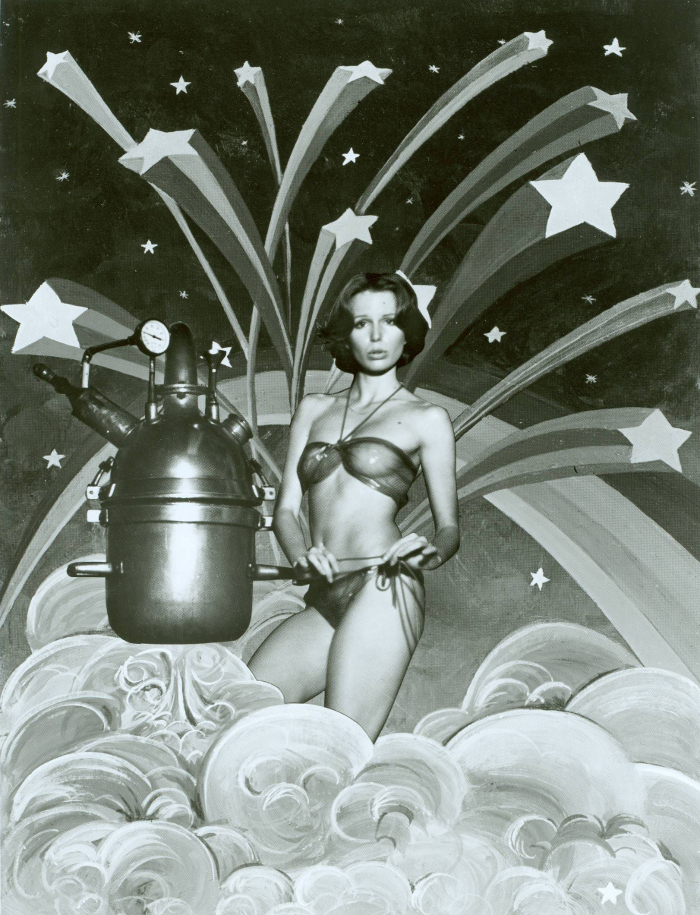
Advertisement for Candypants edible underwear (ca. 1975-1976). Courtesy of Cosmorotics, Inc. Museum of Sex Collection.
Chicago couple David Sanderson and Lee Brady led quite the life: they produced children’s theater and vintage fashion shows, imported Tibetan art, and hung out with David Bowie. They also engaged in a variety of freewheeling creative experiments, the most famous of which was Candypants, which began as a riff on the phrase “eat my shorts.”
The original version of edible underwear was made from an edible film used to wrap turkey, with licorice lacing. “We approached it as conceptual art and as a sexual parody,” Sanderson told KCRW recently.
The hunger for the erotic novelty item proved insatiable, and became huge business.
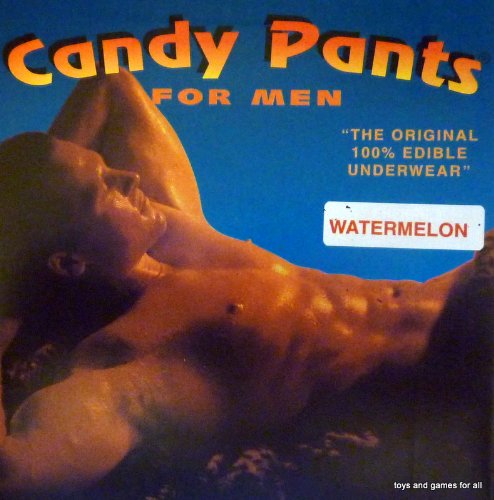
Candypants Male Edible Underwear package. Image via Amazon.com.
The duo went on to hatch a variety of other, less-successful novelties, including, according to People magazine, something called Diamond Jacks, which was like Crackerjacks, except each box contained a gem instead of a toy. After they moved to Miami Beach in 1991, Brady (who, to make matters even more outlandish, is a descendant of 19th-century Civil War photographer Matthew Brady) focused again on his art career—specifically, on images of the nude male form, which have been featured in many volumes, including the recent Best of International Nudes Photography III.

Cabbage Patch Kids at the launch of Dream Toys 2012 at St Mary’s Church on October 31, 2012 in London, England. Photo by Gareth Cattermole/Getty Images.
Any child of the ‘80s will know the Cabbage Patch Kids, the dough-faced, sickly sweet dolls that became one of the biggest toy crazes of the era.
They have, however, a surprisingly contentious origin. They have long been credited to Xavier Roberts, who, as a 21-year-old student, took inspiration from the historic quilting techniques his mother taught him to create what he called the “Little People,” a line of hand-crafted dolls with unique birth certificates that were “adopted,” rather than sold.
Roberts parlayed a first-prize win at the Osceola Art Show into success as a toy purveyor, incorporating as Original Appalachian Artworks, Inc. and eventually changing the name to the Cabbage Patch Kids in 1982.
As it turns out, this heartwarming story has a darker side. A recent Vice documentary alleges that the idea for the dolls, including the hook that you “adopted” a unique character, was stolen from Kentucky artist Martha Nelson Thomas, who developed the concept while working on soft sculpture at an art school in Louisville, creating what she called “Doll Babies.”
In this rather less charming account, Xavier acquired a few of Thomas’s dolls at a craft fair, then, when she refused to work with him, straight-up told her, “If I can’t sell your dolls, I’ll sell something just like them.”
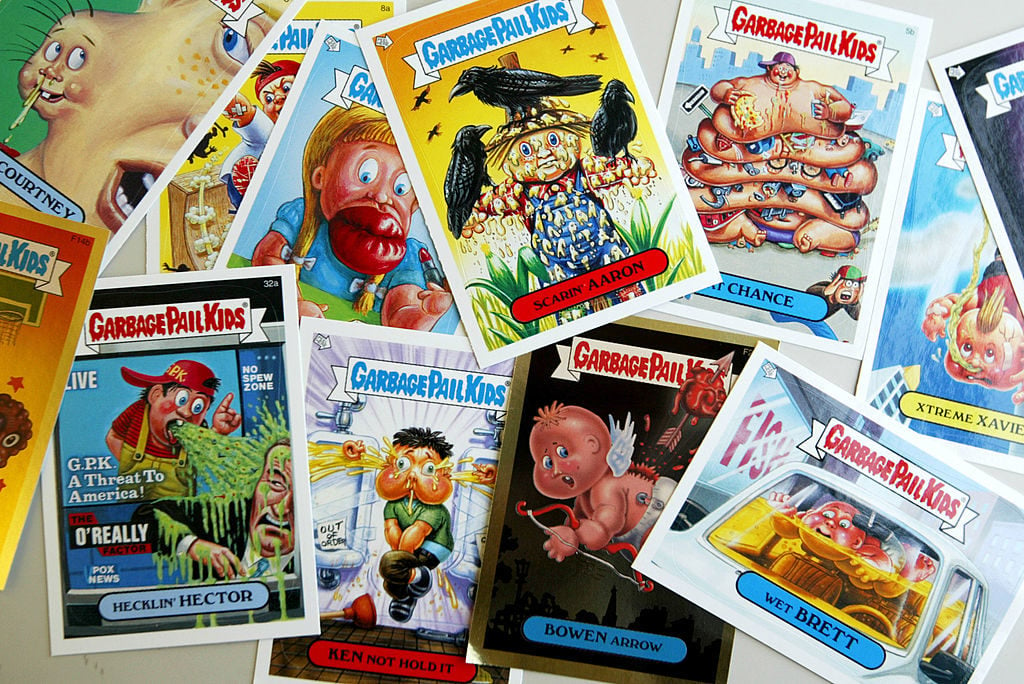
“Garbage Pail Kids” cards are shown March 31, 2004 in New York City. Photo by Chris Hondros/Getty Images.
The Garbage Pail Kids, the satirical trading-card-based response to the Cabbage Patch Kids, became a phenomenon almost as potent—and has its own artistic back story.
With Cabbage Patch fever in full swing in the mid-‘80s, Topps trading card company decided that it would be easier to do a parody than to get a full license to reproduce the toys. Now-legendary cartoonist Art Spiegelman invented the original characters such as “Adam Bomb” and “Potty Scotty” in productively puerile brainstorming sessions with Topps creative director Len Brown.
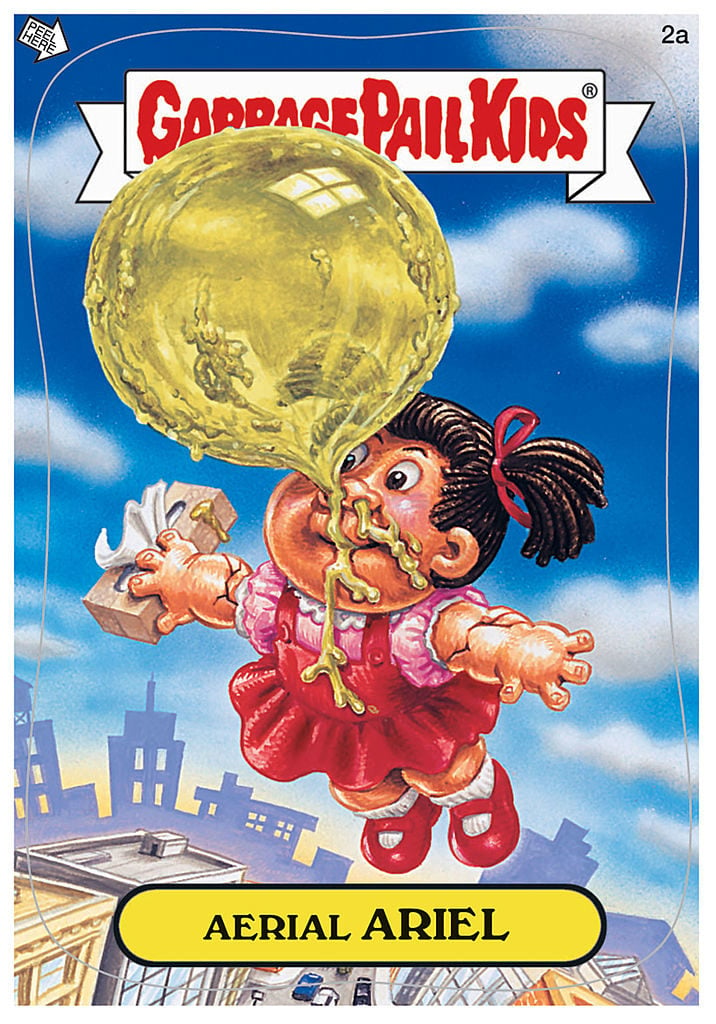
A “Garbage Pail Kids” card is shown March 31, 2004 in New York City. Photo by Topps via Getty Images.
At the time, Spiegelman was still working on his classic graphic novel Maus, which delved into his family’s experience with the Holocaust. It later won the Pulitzer Prize and is widely considered to be the work that proved graphic novels could be art.
Thus, even though Topps artists were usually anonymous, Spiegelman had a special reason to be glad that his work with the Garbage Pail Kids remained obscure, as he explained in a book on the history of the gross-out trading card phenomenon:
“In 1986 it was challenging enough to get people to accept the idea of a serious work about the Holocaust in comic-book form without having to reveal that the artist also created those notorious stickers for the prepubescent set. ‘Please keep it quiet,’ my editor insisted. ‘If this gets out, they’ll review your book and call it ‘Garbage Pail Jews!’”
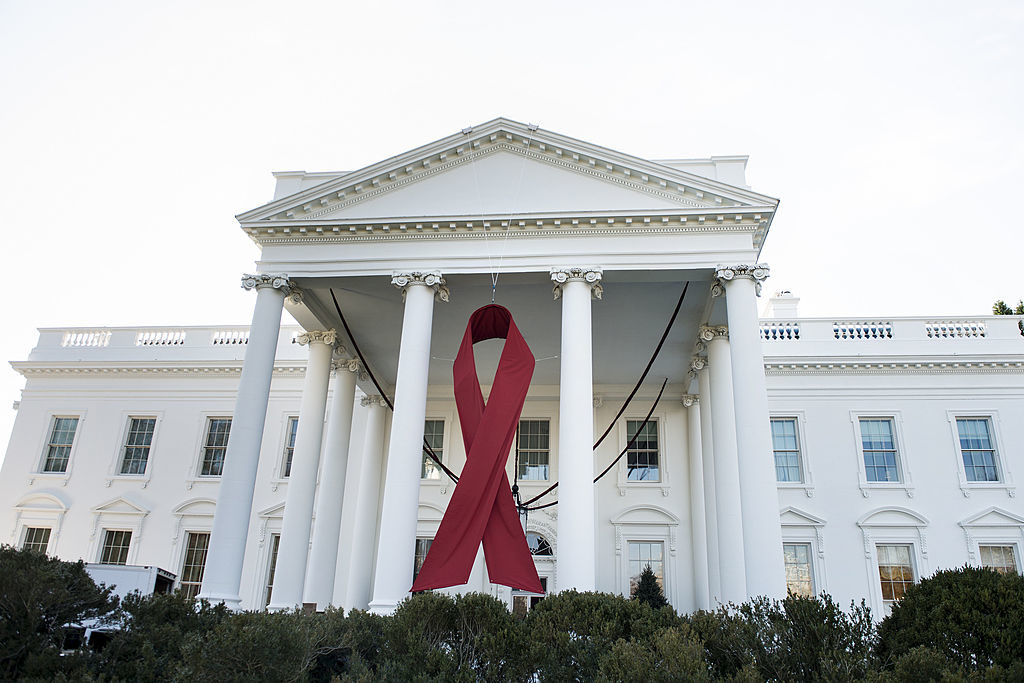
A red ribbon is seen on the North Portico of the White House in honor of World AIDS Day December 1, 2013 in Washington, DC. Photo credit should read Brendan Smialowski/AFP/Getty Images.
The simple looped ribbon, in various colors, worn on the lapel, has become a staple of causes of all kinds. All are the progeny of The Ribbon Project, the collective brainchild of the Visual AIDS Artists’ Caucus, which in 1991 conceived the original red AIDS awareness ribbon.
What started as an art project took on a massive life of its own when the group had the inspiration to get their ribbons onto actors at the Tony Awards. By 1992, the New York Times wrote an article called “The Year of the Ribbon,” suggesting just how quickly the idea became a mass phenomenon.
“People want to say something, not necessarily with anger and confrontation all the time,” Patrick J. O’Connell, part of the original team, said. “This allows them. And even if it is only an easy first step, that’s great with me. It won’t be their last.”
Today, wearing an awareness ribbon is often ridiculed as a low-stakes, purely symbolic form of activism. But in 1991, after more than 31,000 New Yorkers had died of AIDS, its stigma remained widespread and the government was still torpid in the face of the epidemic. “Silence = Death” was a slogan of the day. The Ribbon Project was one effective way to break that silence—which is why it has been so widely copied.
The Red Ribbon design became part of the permanent collection at the Museum of Modern Art in 2015.
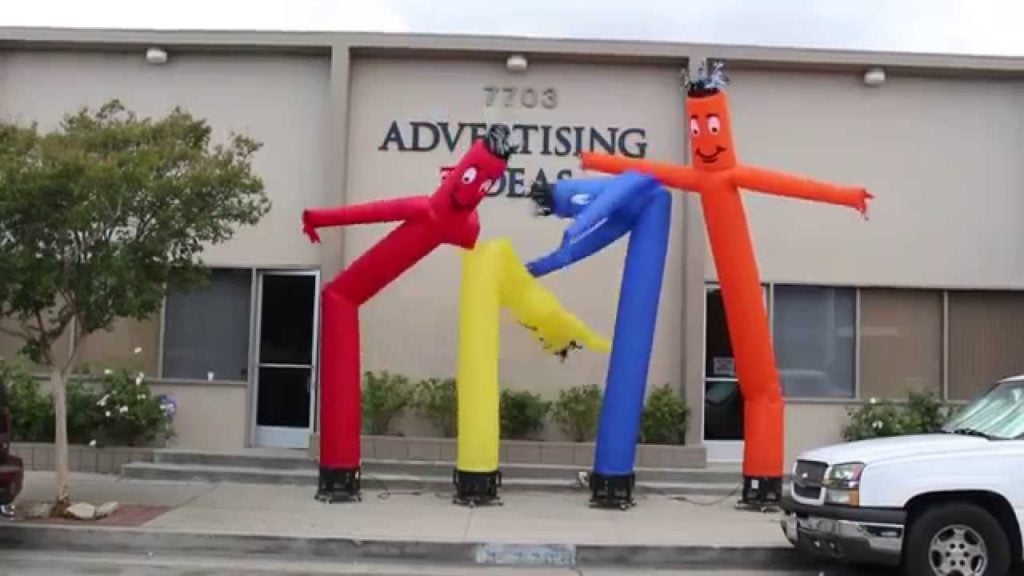
Inflatable balloon dancers by Advertising Ideas. Image via YouTube.
Those tubular, wavy-armed, stick-figure thingies are synonymous these days with car dealerships and gas stations. They have rather more arty origins, however, in the work of Peter Minshall, an artist from Trinidad and Tobago.
Minshall (b. 1941), who graduated from the Central School of Art and Design in London in 1969, is a legend of Carnival in his homeland, creating epic fantasy-themed parades, starting with a Paradise Lost-inspired opus in 1976.
Indeed, so renowned was he for these stupendous bits of street art that he was drafted to work on the ceremonies of three separate Olympics: the Barcelona Summer Olympics in 1992, the Atlanta Summer Olympics in 1996, and the Salt Lake City Winter Olympics in 2002.
It was for the Atlanta Olympics that he hatched the concept of the air dancer, or “tall boy” as he calls it. “I sketched two of the inflatable tubes and joined them at the waist, going into one tube which is the torso; divided them again at the top with the arms and a bit of a head,” he told the T&T Guardian recently. “I saw two legs, two arms; I thought: My God, with a wind source, we could create a huge, incredible, undulating dancing figure.”
A second claim on the innovation is held by Israeli designer Doron Gazit, who worked with Minshall on the Atlanta ceremonies before founding Air Dimensional Design, where he elaborated the dancers (without Minshall’s participation) into the mass-market, commercially available… thing we know today.
Gazit had a show of his pneumatic art at the San Luis Obispo Museum of Art earlier this year, and these days hopes to use the spastic totems as a tool to call attention to climate change.
(The whole story of their dispute is told in a great episode of the podcast 99% Invisible, “Inflatable Men.”)
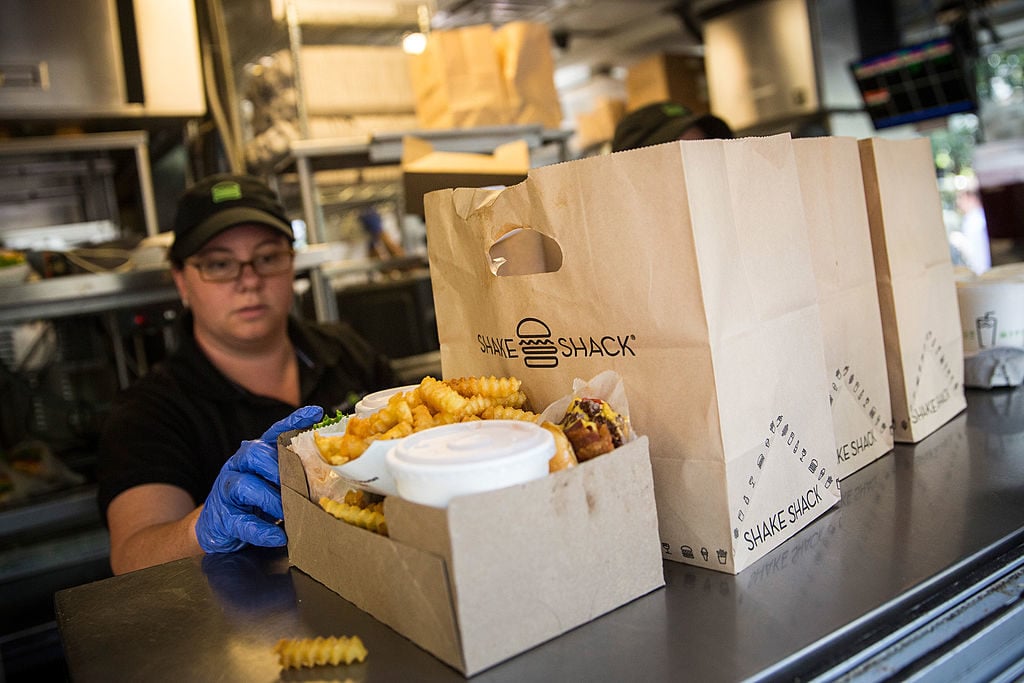
Shake Shack workers prepare orders on August 18, 2014 in Madison Square Park in New York City. Photo by Andrew Burton/Getty Images.
Danny Meyer’s chain of chichi-ish fast-food burgers is everywhere now, from the Mall of America in Minneapolis to various locations in Jeddah, Saudi Arabia. But it began its life as a component of a public art project—specifically, the inaugural installation for the Madison Park Conservancy in 2001, which began as an attempt to revitalize the space.
The inaugural participants were Teresita Fernández, Tobias Rehberger, and Navin Rawanchaikul. For his project, I ♥ TAXI, Rawanchaikul wanted to pay tribute to the two things that the Thai artist found most emblematic of New York: yellow cabs and hot-dog carts. For the former, he put cabs on stilts to create a surreal spectacle; for the latter, he wanted a similarly unexpected twist, so he went to restaurateur Danny Meyer, whose Eleven Madison Park was nearby.
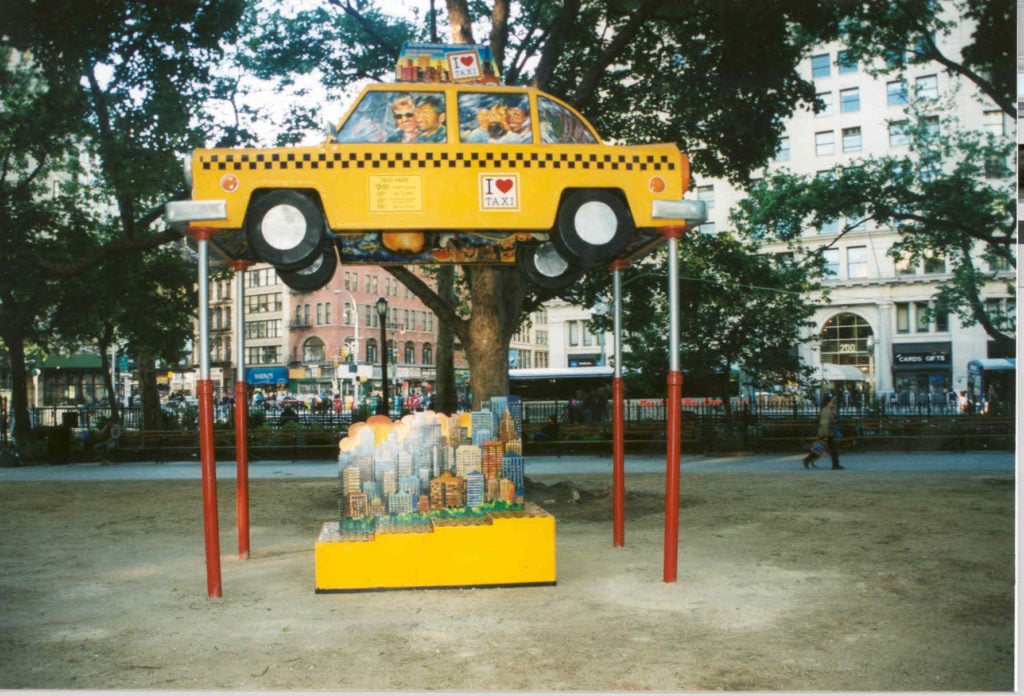
Navin Rawanchaikul’s I ♥ TAXI for “Target Art in the Park” in 2001. Image courtesy Madison Square Park Art.
As Shake Shack culinary director Mark Rosati recounted in an interview:
[Rawanchaikul] came to Danny, and he said, “I know you have these restaurants, would you care to do the hotdog cart?”
Danny loved the idea. He said, “We’re gonna do the hotdogs, we’re gonna do griddled burgers too, and to keep harnessing that Midwest inspiration, why not do frozen custard instead of ice cream? Why not go all in with the inspiration?”
The cart was a big hit, stayed in business for three years, and inspired the founding of the original Shake Shack as a kiosk in the Park.
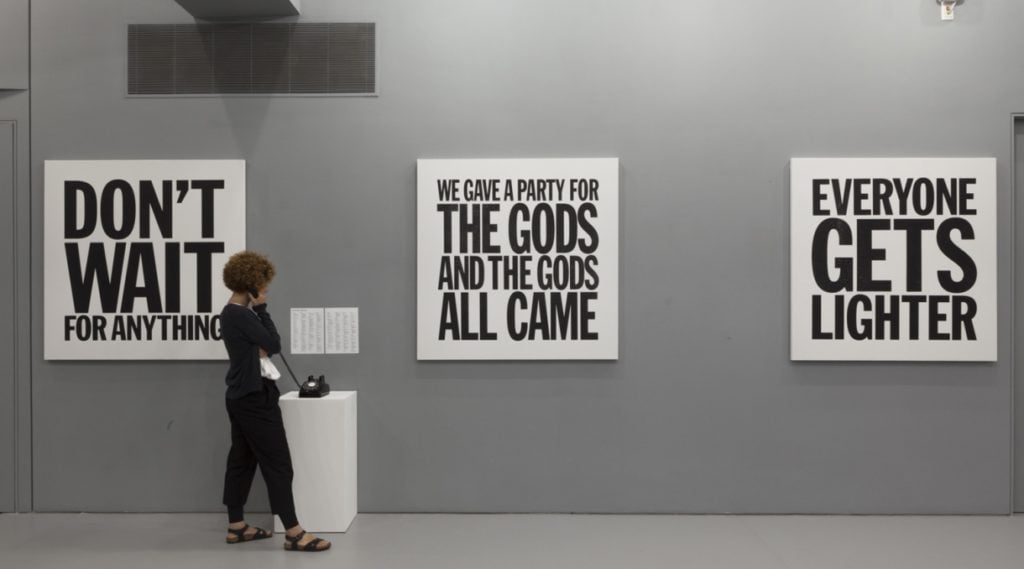
Installation view of Ugo Rondinon’s “I ♥ John Giorno” at Red Bull Arts, featuring Dial-a-Poem. Image courtesy Red Bull Arts.
OK, so this claim may be pretty far out. But it was reiterated recently in the sprawling, multi-venue art show celebrating the legacy of poet John Giorno. Specifically, it regards Giorno’s massive interactive communications project, Dial-a-Poem. Here’s the case:
Giorno was a habitué of the scenes around Robert Rauschenberg, Jasper Johns, and Andy Warhol (whom he dated). These media-smart art stars were an inspiration: “The use of modern mass media and technologies by these artists made me realize that poetry was 75 years behind painting and sculpture, dance, and music,” he once said.
This epiphany, in turn, inspired him to found Giorno Poetry Systems, which allowed people to call in to have poems read to them by the likes of John O’Hara and Allen Ginsberg.
In an age before any such remote information services existed, it made a splash: Kynaston McShine included Dial-a-Poem in his groundbreaking 1970 exhibition “Information,” which mainstreamed Conceptual Art. More importantly, it was a huge popular hit, proving that such services could have mass appeal.
“Dial-A-Poem began at the Architectural League of New York in January 1969 with 10 telephone lines and ran for 5 months, during which time 1,112,337 calls were received,” Giorno once explained. “It continued at MOMA in July 1970 with 12 telephone lines and ran for 2 and a half months and 200,087 calls were received. It was at The Museum of Contemporary Art, Chicago for 6 weeks in November 1969 and since then has cropped up everywhere.”
Because of all the attention it generated, Giorno has claimed that Dial-a-Poem laid the groundwork for many decidedly less creative uses of the phone lines: “Not only did we ourselves get millions of calls, we inspired the creation of dial-for-stock market info and dial-for-sports info services, etc. We also foreshadowed by a generation the explosion of 1-900 telephone promotions, not to mention the delivery of the Internet over phone lines.”
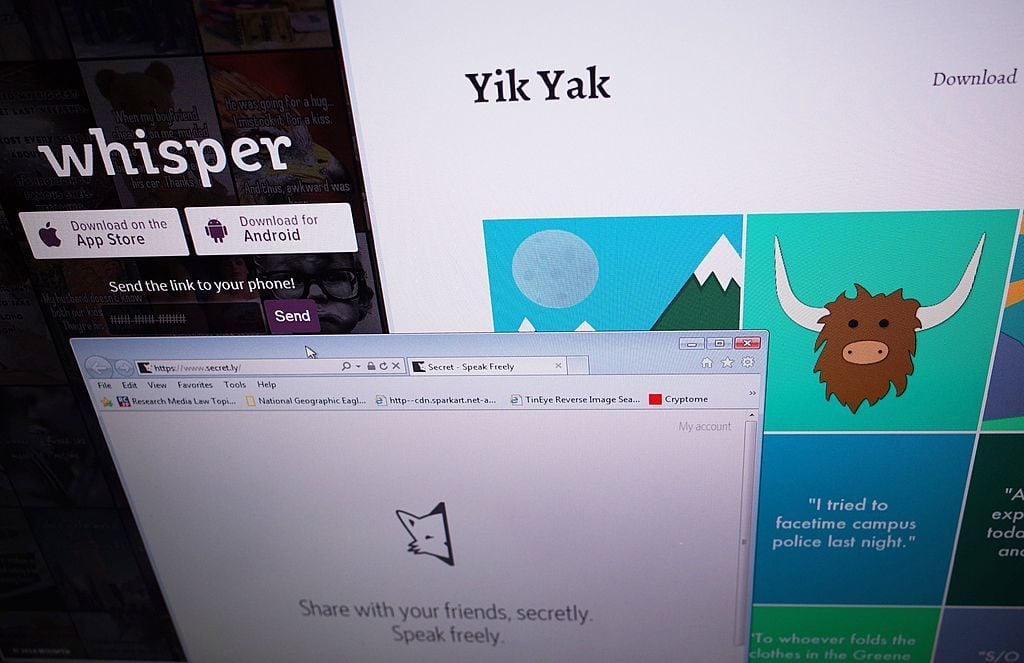
Websites for anonymous social networking apps Whisper and Yik Yak. Photo by Mandel Ngan/AFP/Getty Images.
In the last few years, tens of millions of dollars in venture capital have poured into anonymous social-media networks including Yik Yak and Whisper, with investors betting that they may be the next big thing. “If you look at the dozens of apps today,” Frank Warren told Buzzfeed in 2014, “the PostSecret app was really the predecessor.”
PostSecret, launched it in 2004, wasn’t a business; it was an “ongoing community art project.” As an artwork, it was a creature of the web—but not completely—just on the cusp of the moment when everything went online. Warren invited people to mail him a secret written on a postcard, and then he scanned them and posted them anonymously to his website.
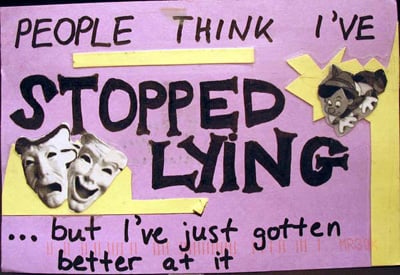
Postcard image from PostSecret.com.
The site became hugely popular, attracting thousands of postcards per week (the two most common confessions, according to Warren, were some variation on the yearning for a soulmate and “I pee in the shower.”) It led to books and art shows featuring the juiciest Secrets, scored Warren a TED Talk (and many other speaking engagements), and raised lots of money for suicide-prevention charities.
As for the new crop of secret sharing apps, there is a bitter feud.
Warren’s own attempt to launch a PostSecret app was laid low, he told Fortune, by a flood of abusive contributions funneled from a service called TigerText—which also happens to be the company that incubated Whisper. Warren seems to think that fact is less than a coincidence, though he can prove no real wrongdoing.
“Some of the people using the [Whisper] app contacted me,” Warren said. “They were upset because in some ways they felt like the same person who was kind of running TigerText in some ways might have been responsible for the downfall of the PostSecret app. There’s no evidence for this. But to pretty much create another app that’s ninety to ninety-five percent the same as the PostSecret app? And get, I don’t know, some people say $60 million dollars in venture funding? It had some people upset. It was difficult for me to hear those stories.”
Whisper denied the insinuation, telling Fortune “we are big fans of Frank and his mission, and in fact have reached out to him numerous times.”
Without the human touch of PostSecret, though, things haven’t gone so great for the app-based rivals.

A message posted to Whisper.
Yik Yak collapsed earlier this year under the weight of its association with campus harassment, while Whisper just laid off a fifth of its staff—though it still claims to have 20 million monthly active users.
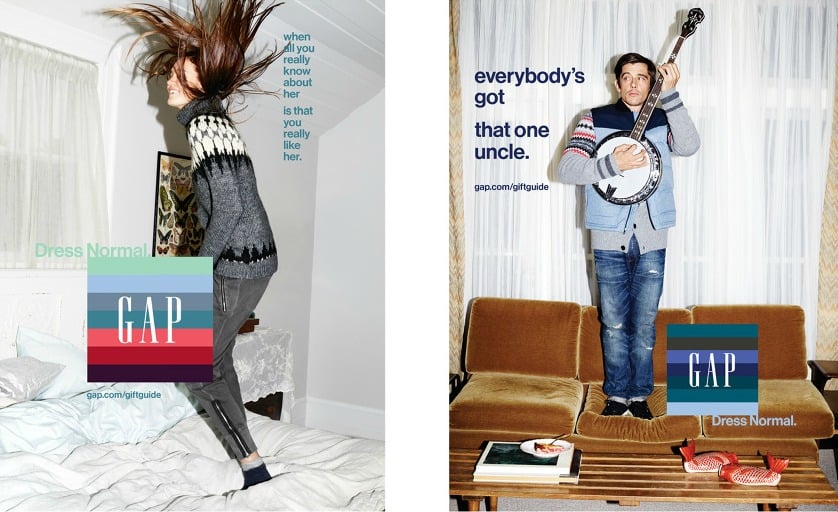
Images from The Gap’s “Dress Normal” campaign, 2014.
The term “normcore”—per Dictionary.com, “a fashion style or way of dressing characterized by ordinary, plain clothing with no designer names, often a reaction against trendy fashion”—was popularized by K-HOLE, a New York-based trend-forecasting consortium that itself could belong on this list.
The group was founded by Greg Fong, Sean Monahan, Emily Segal, Chris Sherron, and Dena Yago, grads of Brown and RISD, back in 2010. K-HOLE’s “trend-casting” reports, all available on their site, originated as a kind of poker-faced satire of corporate research, with an art audience in mind.
By 2013, they were already starting to get offers to from actual corporations—and that was before their late-2013 release of “Youth Mode: A Report on Freedom.”
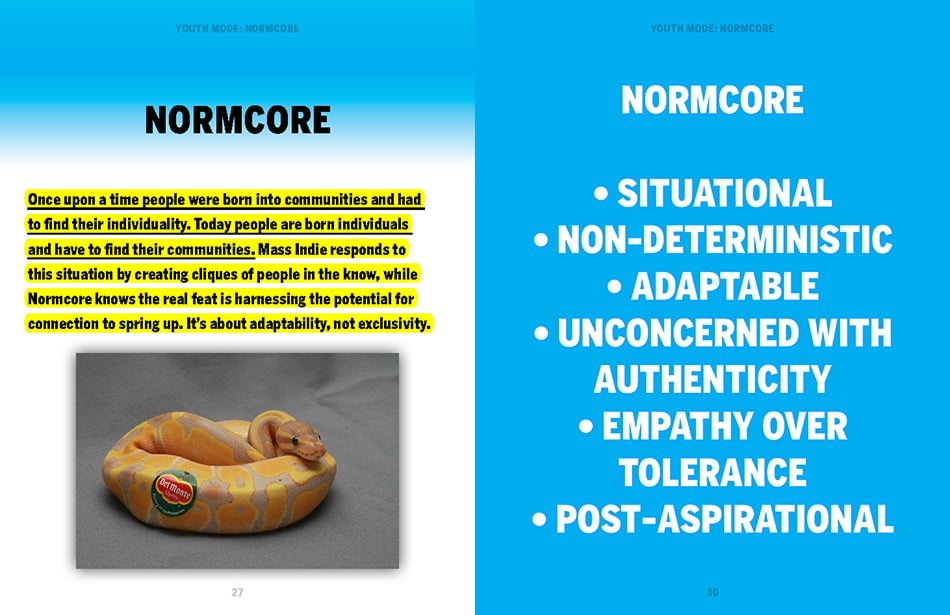
A page from K-HOLE’s Youth Mode: A Report on Freedom
(2014).
The idea of normcore fashion “came out of nowhere—it wasn’t linked to any data research,” the group told the Guardian. But New York Magazine’s The Cut blog grabbed hold of the snappy bit of jargon, and “normcore” became a veritable fashion trend, or anti-trend, or whatever, with the Gap shortly thereafter exhorting consumers to “Dress Normal.”
“Nike, Google, Samsung, and North Face all got in touch,” Segal told Fast Company. K-HOLE’s website now boasts consulting gigs for MTV, Coach, and Stella Artois, among others.

The maintenance facility for the El Paso Streetcar Project. Image courtesy SunMetro.
It may be hard to imagine, with contemporary paranoia about the southern US border at a fever pitch, but from 1949 to 1974, trolley cars made the trip between El Paso and Juarez without much controversy.
The idea to revive the line, however, began at the School of Visual Arts in New York in 2010, when a student from El Paso, Peter Svarzbein, took the idea of the trans-border street car as an inspiration for his MFA graduate thesis. As he told his alma mater recently, looking back:
I recorded a series of video ads that imagined this bored guy and girl in El Paso. And they’re like, “There’s nothing to do…. Oh, let’s go take the trolley [to Juarez].” And all of a sudden the conductor magically appears. And then I created these posters of over-the-top, militantly positive ideas, concepts and sayings—“Let Us Take You Home on Either Side of the Border,” “The Future Is Arriving on Time on the Border Again”—as a way to imagine something better. And that was kind of it: if we’re going to have something better for the border, we have to imagine what that can look like. It’s sort of utilizing the framework of an ad campaign to talk about these real issues.
Svarzbein then went on a sustained postering campaign in El Paso—which had an impact, inspiring people to contact their government representatives and enthuse about the plan.

Peter Svarzbein’s poster for Alex the Conductor. Image courtesy SVA.
These days, Svarzbein is an elected representative for District 1 of El Paso. The Texas Department of Transportation has earmarked $97 million for Phase One of the revived trolley. The second phase—the one that actually traverses the border to Juarez—is still under scrutiny.
As Svarzbein told SVA, “at the end of the day, I think that an artist is able to see the world not as it is, but what it can be. Politics is a medium the same way painting, sculpture, or photography is one.”